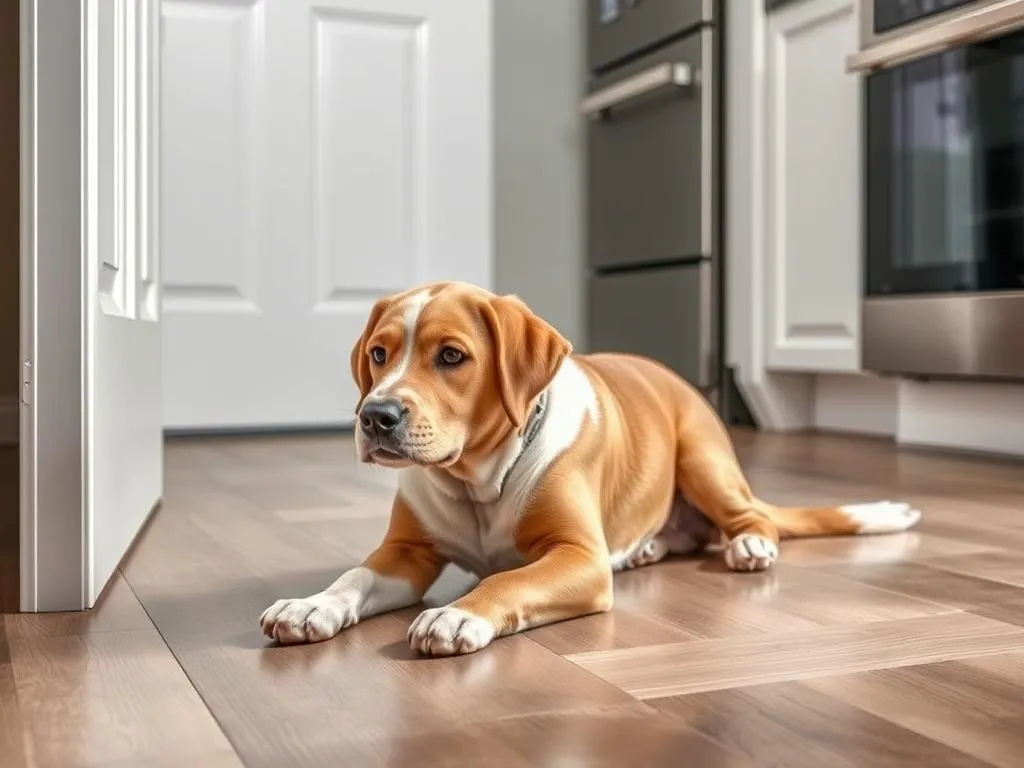
Introduction
If you’ve ever watched your dog cautiously maneuver across a slick floor, you know that how to keep dogs from slipping and sliding on floors is a significant concern for many pet owners. The challenge of maintaining a safe environment for our furry friends is paramount, not just for their physical safety but also for their comfort and confidence. Slipping can lead to injuries, stress, and even behavioral issues. In this article, we will explore the causes of slipping, evaluate your home environment, delve into effective solutions, and discuss training techniques that can help your dog navigate slippery surfaces. Let’s ensure that your four-legged companion can roam freely and safely in your home!
Understanding the Problem
Causes of Slipping and Sliding
When it comes to flooring, some materials are more prone to causing slips than others. Common flooring types like hardwood, tile, and laminate can be especially hazardous for dogs, particularly for those with sensitive joints or less traction in their paws. Factors such as breed, size, weight, and paw structure significantly influence how dogs interact with these surfaces.
For instance, breeds with broader paws or heavier builds may have an easier time maintaining balance, while smaller or lighter breeds often struggle. Understanding these dynamics is crucial in addressing the issue of slipping in your home.
Risks Associated with Slipping
The risks associated with dogs slipping on floors are not to be taken lightly. Dogs can suffer from various injuries, including sprains, fractures, and long-term joint issues, which can significantly impact their quality of life. Additionally, the psychological effects of slipping can manifest as fear or anxiety, making your dog hesitant to move around the house. This can lead to behavioral changes and even a reluctance to engage in play or exercise, further affecting their overall well-being.
Evaluating Your Home Environment
Assessing Your Floors
To effectively prevent slips, it’s essential to evaluate your home environment. Start by identifying high-risk areas where your dog might be most vulnerable, such as hallways, kitchens, and entryways. Moreover, consider your dog’s age and health; older dogs or those with pre-existing conditions may require extra precautions to prevent slipping.
Choosing the Right Flooring
When it comes to selecting flooring that is less slippery, understanding the pros and cons of various materials can help you make informed choices.
- Hardwood: While aesthetically pleasing, hardwood can be slippery. However, certain finishes can enhance traction.
- Tile: Often cold and slick, tile flooring can pose a significant risk, especially in kitchens and bathrooms.
- Laminate: Similar to hardwood, laminate can be slippery but is usually more affordable.
For those looking for more pet-friendly flooring options, consider materials like cork, rubber, or carpet, all of which provide better traction and are easier on your dog’s joints.
Effective Solutions to Prevent Slipping
Non-Slip Floor Treatments
One effective way to combat slipping is by applying non-slip treatments to your floors. These coatings can provide excellent traction and are especially beneficial for hard surfaces.
Step-by-Step Guide for Application:
1. Clean the Floor: Ensure the surface is free from dust, dirt, and grease.
2. Choose the Right Product: Look for non-slip treatments specifically designed for your flooring type.
3. Apply Evenly: Follow the manufacturer’s instructions for application.
4. Allow Adequate Drying Time: Ensure the treatment is completely dry before allowing your dog to walk on it.
Dog-Friendly Mats and Rugs
Incorporating dog-friendly mats and rugs can also mitigate slipping. Look for mats made from materials like rubber or low-pile carpet, which offer better traction than traditional rugs.
When choosing a mat, consider the following:
– Size: Ensure it covers high-traffic areas.
– Material: Opt for non-slip materials that are easy to clean.
– Durability: Select mats that can withstand wear and tear from your dog’s activity.
Paw Care and Maintenance
Regular paw care plays a vital role in preventing slips. Keeping your dog’s nails trimmed is essential, as long nails can hinder traction and increase the likelihood of slips. Furthermore, consider using paw pad conditioning creams or balms to maintain the health and grip of your dog’s paw pads.
Training Your Dog to Navigate Slippery Surfaces
Basic Commands and Training Techniques
Training your dog to navigate slippery surfaces can significantly reduce the risk of slipping. Teaching basic commands like “slow” or “easy” can encourage your dog to be more cautious. Use positive reinforcement techniques, such as treats or praise, to reward your dog for exhibiting safe behavior on slippery floors.
Desensitization Techniques
Gradual exposure to slippery surfaces can help desensitize your dog to the sensation of slipping. Start by introducing your dog to these surfaces slowly, allowing them to explore while providing encouragement and support. Incorporating exercises that build confidence, such as walking across a non-slip mat or rug, can further enhance their comfort level.
Additional Safety Measures
Using Dog Booties
Dog booties can be an effective solution for improving traction. These come in various styles, materials, and sizes to fit your dog’s needs.
Pros:
– Enhanced grip on slippery surfaces.
– Protection from hot or cold surfaces.
Cons:
– Some dogs may resist wearing booties.
– They require monitoring to ensure a proper fit.
Installing Safety Features
Consider installing additional safety features in your home to further reduce slipping risks. Ramps can be beneficial for dogs with mobility issues, allowing them to navigate stairs safely. Non-slip stair treads can also help enhance safety on stairs. Finally, keeping your home environment clear of obstacles can minimize the risk of accidents.
Consulting with Professionals
When to Seek Veterinary Advice
If you notice any signs that your dog may have already injured itself, such as limping or reluctance to move, it’s essential to seek veterinary advice. Discussing slipping issues with your vet can provide insights into any underlying health concerns that may need to be addressed.
Professional Training Assistance
If you’re struggling to train your dog to navigate slippery surfaces, consider seeking professional help. A qualified dog trainer can provide tailored strategies and support, whether through group classes or one-on-one sessions.
Conclusion
Preventing slips and falls for dogs is crucial for their safety, comfort, and overall well-being. By understanding the challenges, evaluating your home environment, implementing effective solutions, and fostering the right training techniques, you can create a safer space for your furry friend. Taking these proactive steps not only ensures a secure home but also enhances your dog’s confidence and happiness. Remember, every dog deserves a safe environment to thrive in, and your efforts will undoubtedly pay off in their well-being.
This article provides a comprehensive guide on how to keep dogs from slipping and sliding on floors, ensuring that you and your furry companions can navigate your home safely and confidently.









